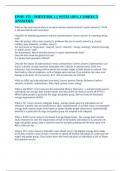EPHE 155 - MIDTERM 1 || WITH 100% CORRECT
ANSWERS.
What are the main reasons there is so much nutrition misinformation? correct answers 1. Profit
2. Personal beliefs and convictions
Checklist for identifying potential nutrition misinformation correct answers Is something being
sold?
Does the product offer a new remedy for problems that are not easily solved (e.g. obesity,
cellulite, poor immunity, wrinkles, stress?)
Are such terms as 'miraculous', 'magical', 'secret', 'detoxify', 'energy restoring', 'immune boosting'
or 'studies prove' used?
Are testimonials, before-and-after photos or expert endorsements used?
Does the info sound too good to be true?
Is a money-back guarantee offered?
Describe the impact of undernutrition versus overnutrition? correct answers Undernutrition can
lead to a decline in body functions associated with a decline in nutrient status. With iron
deficiency, iron containing proteins and in turn oxygen supply to body tissues is reduced. This
then leads to clinical symptoms, such as fatigue upon exertion. Over nutrition can cause toxic
damage to the body. In iron toxicity, liver cells in particular are affected.
What are DRIs and what nutrients have them? correct answers Dietary Reference Intakes -
vitamins, minerals, carbohydrates, fibre, lipid, protein, water, energy
What is and RDA? correct answers Recommended Dietary Allowance - a nutrient intake goal for
individuals, the average daily nutrient intake level that meets the needs of nearly all (97% to
98%) healthy people in particular life stage and gender group. Derived from the Estimated
average requirements (EAR).
What is AI? correct answers Adequate Intake - nutrient intake goals for individuals are set
whenever scientific data are insufficient to allow establishments of an RDA value; recommended
average daily nutrient intake level based on intakes healthy people (observed or experimentally
derived) in a particular life stage and gender group and assumed to be adequate.
What is EAR? correct answers Estimated Average Requirement - the average daily nutrient
intake estimated to meet the requirements of half of the healthy individuals in a particular life
stage and gender group; used in nutrition research and policymaking and the basis upon with
RDA values are set.
What is UL? correct answers Tolerable Upper Intake Level - the highest average daily intake
levels that is likely to pose no risk of toxicity to almost all healthy individuals of a particular life
stage3 and gender group. Usual intake above this level may place an individual at risk of illness
from nutrient toxicity.
, What is CDRR? correct answers Chronic Disease Risk Reduction - a new DRI category based on
chronic disease risk of; for example, keeping the sodium intake below the CDRR is expected to
reduce the risk of chronic disease for the otherwise healthy population, while intakes above it
will increase it.
What is AMDR? correct answers Acceptable Macronutrient Distribution Range - values for
carbs. fats, and protein expressed as percentages of total daily caloric intake, ranges of intakes set
for the energy yielding nutrients that are sufficient to provide adequate total energy and nutrients
while reducing the risk of chronic disease.
What is a DVT? correct answers Daily Value - nutrient reference standards used on food labels,
in grocery stores (and on some restaurant menus and websites in Canada and the US). The DV
allow comparisons among foods with regards to their nutrient contents.
What food products come with nutrition facts? correct answers Almost all prepackaged foods
have Nutrition Facts.
Some exceptions are:
- fresh fruit and vegetables;
- raw meat, poultry, fish and seafood;
- foods prepared or processed at the store:
bakery items, sausage, salads;
- foods that contain very few nutrients: coffee beans, tea leaves, spices;
- alcoholic beverages. 41
According to Canadian law what must most food labels include? correct answers - Common or
usual name of the product
- Name/address of the manufacturer, packer, or distributor
- Net contents by weight, measure, or count
- Nutrition Facts label
- The ingredients, in ordinary language, by descending order of predominance by weight
- The label must state the contents of these nutrients expressed as %DV: vitamin A, vitamin C,
calcium, iron
- The %DVs are of two types: An intake goal to strive for: fibre, protein,
vitamins, and most minerals and healthy daily maximums: cholesterol, total fat, the sum of
saturated fat and trans fat, and sodium.
What does food provide? correct answers - Energy for body processes.
- Heat for body temperature regulation.
- Building blocks for growth and maintenance of body tissues.
What are the different types of digestion? correct answers Mechanical - the physical breakdown
of large food molecules into smaller molecules.
Chemical - the enzymatic reactions that break down large food molecules.
During the digestive process of chewing, the epiglottis is 1.______________ and the esophagus
is 2.______________. While during swallowing the reverse occurs as the 3._____________ rises




